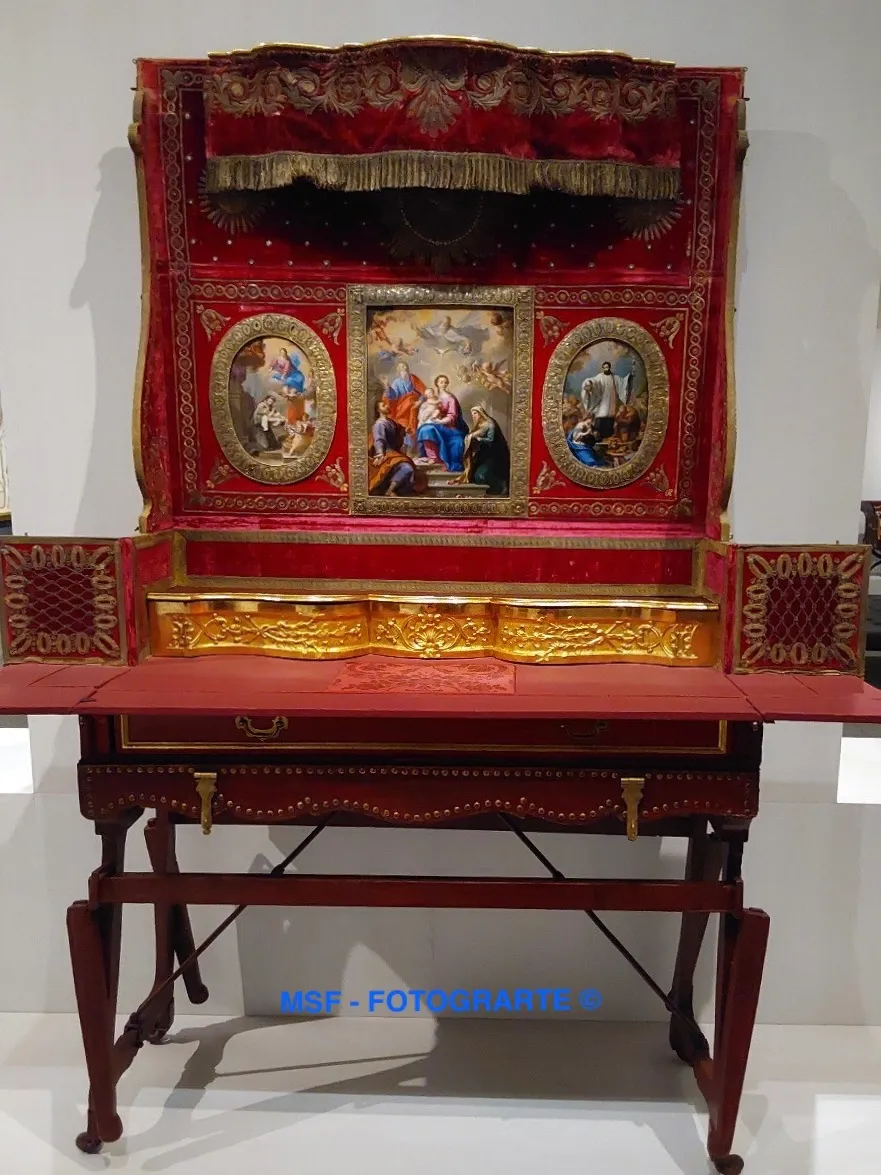
Fechado en 1734, es el altar portátil más antiguo de los que aún conserva Patrimonio Nacional, con la sola excepción del del platero Juan Rodríguez de Babia (Siglo XVI).
DE la información en la web de la Galería:
Corresponde al reinado de Felipe V y fue realizado para el príncipe de Asturias, Fernando de Borbón (1713-1759) ―futuro Fernando VI―, siendo empleado después por su esposa la reina Bárbara de Braganza (1711-1758), como indican las tachuelas claveteadas en el cuero exterior: «ORATORIO DE LA REI.A / NRA. SEÑ.A» (las letras tras los puntos, en voladita).
Con forma de arcón desplegable y forrado al exterior de cuero teñido de rojo, tiene su interior decorado con talla dorada, terciopelo rojo con bordados en hilo de plata sobredorada y, bajo dosel, tres cobres pintados al óleo por Andrés de la Calleja (1705-1785). La escena principal representa a «La Sagrada Familia con san Joaquín y santa Ana» y está firmada en la grada superior en letras capitales: «A. CALLEXA, F.A / 1734» (la «A» de la abreviatura, en voladita). La composición viene presidida por Dios Padre y el Espíritu Santo, conformando con el Niño la Santísima Trinidad. La escena está resuelta en la estética dominante de Carlo Maratta a través de su discípulo Andrea Procaccini. El cobre central está flanqueado por los óvalos de «San Antonio de Padua con el Niño Dios», a la izquierda, y «San Francisco Javier bautizando conversos», a la derecha, los tres enmarcados con galón dorado. La figura de san Antonio de Padua con el Niño en brazos se asemeja formalmente al grabado de Simone Cantarini, en la que el Hijo de Dios echa las manos hacia el rostro del religioso. San Francisco Javier, con cruz en la mano, alba blanca y estola, como suele ser representado el misionero jesuita, está bautizando conversos vertiendo de una jarra abundante agua sobre la cabeza de una mujer lujosamente ataviada, con varios indígenas empenachados alrededor, atendiendo a su sobrenombre de Apóstol de las Indias.
Una de las características fundamentales de este altar es que tiene ruedas/ruedines, de tal forma que puede moverse sin problemas, lo que facilitó enormemente su uso para distintas ceremonias privadas.
From the Gallery’s webpage:
This great portable altar corresponds to the reign of Philip V and was made for the Prince of Asturias, Fernando de Borbón (1713-1759) ―future Fernando VI―, being later used by his wife Queen Barbara of Braganza (1711-1758), as indicated by the studs nailed to the outer leather: «ORATORIO DE LA REI.A / NRA. SEÑ.A» (the letters after the dots, in a cantilever).
Shaped like a folding chest and lined on the outside with red-dyed leather, its interior is decorated with gilded carving, red velvet with embroidery in gilded silver thread and, under the canopy, three copper paintings painted in oil by Andrés de la Calleja (1705-1785). The main scene represents «The Holy Family with Saint Joachim and Saint Anne» and is signed on the upper tier in capital letters: «A. CALLEXA, F.A / 1734» (the «A» of the abbreviation, in a cantilever). The composition is presided over by God the Father and the Holy Spirit, forming the Holy Trinity with the Child. The scene is resolved in the dominant aesthetic of Carlo Maratta through his disciple Andrea Procaccini. The central copper is flanked by the ovals of «Saint Anthony of Padua with the Child Jesus«, on the left, and «Saint Francis Xavier baptizing converts«, on the right, all three framed with gold braid. The figure of St Anthony of Padua with the Child in his arms formally resembles the engraving by Simone Cantarini, in which the Son of God reaches out his hands towards the face of the religious man. St Francis Xavier, with a cross in his hand, a white alb and a stole, as the Jesuit missionary is usually represented, is baptising converts by pouring abundant water from a jug over the head of a luxuriously dressed woman, with several indigenous people wearing headdresses around her, in keeping with his nickname of Apostle of the Indies.
One of the fundamental characteristics of this altar is that it has wheels/casters, so that it can be moved without problems, which greatly facilitated its use for different private ceremonies.

